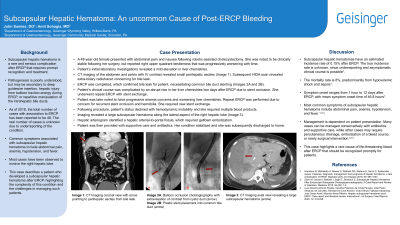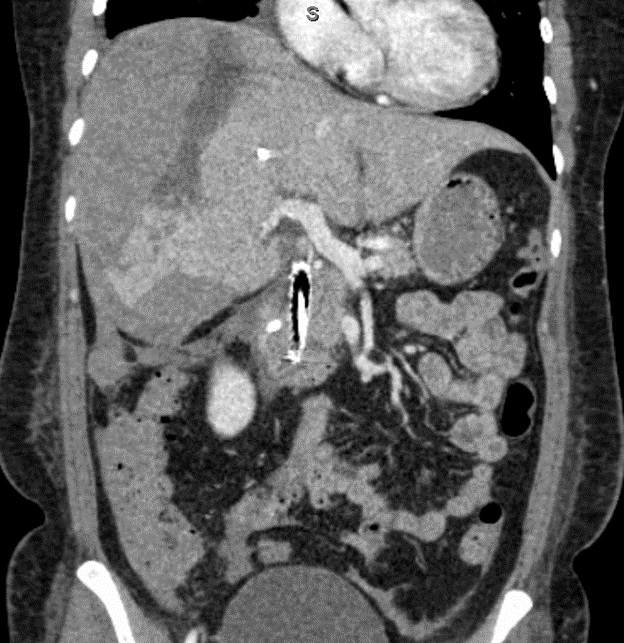Monday Poster Session
Category: Interventional Endoscopy
P2835 - Subcapsular Hepatic Hematoma: An Uncommon Cause of Post-ERCP Bleeding
Monday, October 28, 2024
10:30 AM - 4:00 PM ET
Location: Exhibit Hall E

Has Audio

John Samies, DO
Geisinger Health System
Mountain Top, PA
Presenting Author(s)
John Samies, DO1, Amit Sohagia, MD2
1Geisinger Health System, Mountain Top, PA; 2Geisinger Community Medical Center, Scranton, PA
Introduction: Subcapsular hepatic hematoma is a rare and serious complication after ERCP that requires prompt recognition and treatment. Pathogenesis is poorly understood, but may be secondary to deep guidewire insertion or hepatic injury from balloon traction energy during ERCP. As of 2018, the total number of cases with association to ERCP has been reported to be 48. However, the real number of cases is unknown, since underreporting is possible. This case describes a patient who developed a subcapsular hepatic hematoma after ERCP, highlighting the complexity of this condition and challenges in managing such patients.
Case Description/Methods: A 48-year-old female presented with abdominal pain and nausea following robotic-assisted cholecystectomy. She was noted to be clinically stable, with only right upper quadrant tenderness on examination. Laboratory investigations revealed a mild elevation in liver chemistries. CT imaging of the abdomen and pelvis with IV contrast revealed small perihepatic ascites. Patient underwent HIDA scan, which revealed extra-biliary radiotracer concerning for bile leak.
ERCP confirmed bile leak, necessitating common bile duct stenting. Patient’s clinical course was complicated by an abrupt rise in her liver chemistries and drop in hemoglobin two days after ERCP. She underwent repeat ERCP, which revealed evidence of haemobilia and stent occlusion from blood clot.
Patient’s status continued to decline with further drop in hemoglobin, worsening jaundice, and hypotension. She required multiple blood products within a 24-hour period. New imaging revealed a large subcapsular hematoma along the lateral aspect of the right hepatic lobe. Hepatic arteriogram identified a hepatic arterial-to-portal fistula, which required gelfoam embolization. Patient was then provided with supportive care and antibiotics. Her clinical course stabilized, and she was discharged to home.
Discussion: Subcapsular hepatic hematomas have an estimated incidence rate of 0.15% after ERCP. The mortality rate is 8%, predominantly from hypovolemic shock and sepsis. Symptoms may vary and include abdominal pain, anemia, hypotension, and fever. Most cases involve the right hepatic lobe. Treatment is dependent on patient presentation. Many cases can be managed conservatively, while other cases may require percutaneous drainage, embolization of bleed source, or rarely surgical intervention. This case highlights a rare cause of life-threatening bleed after ERCP that should be recognized promptly for patients.

Disclosures:
John Samies, DO1, Amit Sohagia, MD2. P2835 - Subcapsular Hepatic Hematoma: An Uncommon Cause of Post-ERCP Bleeding, ACG 2024 Annual Scientific Meeting Abstracts. Philadelphia, PA: American College of Gastroenterology.
1Geisinger Health System, Mountain Top, PA; 2Geisinger Community Medical Center, Scranton, PA
Introduction: Subcapsular hepatic hematoma is a rare and serious complication after ERCP that requires prompt recognition and treatment. Pathogenesis is poorly understood, but may be secondary to deep guidewire insertion or hepatic injury from balloon traction energy during ERCP. As of 2018, the total number of cases with association to ERCP has been reported to be 48. However, the real number of cases is unknown, since underreporting is possible. This case describes a patient who developed a subcapsular hepatic hematoma after ERCP, highlighting the complexity of this condition and challenges in managing such patients.
Case Description/Methods: A 48-year-old female presented with abdominal pain and nausea following robotic-assisted cholecystectomy. She was noted to be clinically stable, with only right upper quadrant tenderness on examination. Laboratory investigations revealed a mild elevation in liver chemistries. CT imaging of the abdomen and pelvis with IV contrast revealed small perihepatic ascites. Patient underwent HIDA scan, which revealed extra-biliary radiotracer concerning for bile leak.
ERCP confirmed bile leak, necessitating common bile duct stenting. Patient’s clinical course was complicated by an abrupt rise in her liver chemistries and drop in hemoglobin two days after ERCP. She underwent repeat ERCP, which revealed evidence of haemobilia and stent occlusion from blood clot.
Patient’s status continued to decline with further drop in hemoglobin, worsening jaundice, and hypotension. She required multiple blood products within a 24-hour period. New imaging revealed a large subcapsular hematoma along the lateral aspect of the right hepatic lobe. Hepatic arteriogram identified a hepatic arterial-to-portal fistula, which required gelfoam embolization. Patient was then provided with supportive care and antibiotics. Her clinical course stabilized, and she was discharged to home.
Discussion: Subcapsular hepatic hematomas have an estimated incidence rate of 0.15% after ERCP. The mortality rate is 8%, predominantly from hypovolemic shock and sepsis. Symptoms may vary and include abdominal pain, anemia, hypotension, and fever. Most cases involve the right hepatic lobe. Treatment is dependent on patient presentation. Many cases can be managed conservatively, while other cases may require percutaneous drainage, embolization of bleed source, or rarely surgical intervention. This case highlights a rare cause of life-threatening bleed after ERCP that should be recognized promptly for patients.

Figure: CT abdomen/pelvis with IV contrast reveals a large subcapsular hepatic hematoma measuring 15.1 x 6.5 cm along the lateral aspect of the right hepatic lobe.
Disclosures:
John Samies indicated no relevant financial relationships.
Amit Sohagia indicated no relevant financial relationships.
John Samies, DO1, Amit Sohagia, MD2. P2835 - Subcapsular Hepatic Hematoma: An Uncommon Cause of Post-ERCP Bleeding, ACG 2024 Annual Scientific Meeting Abstracts. Philadelphia, PA: American College of Gastroenterology.
